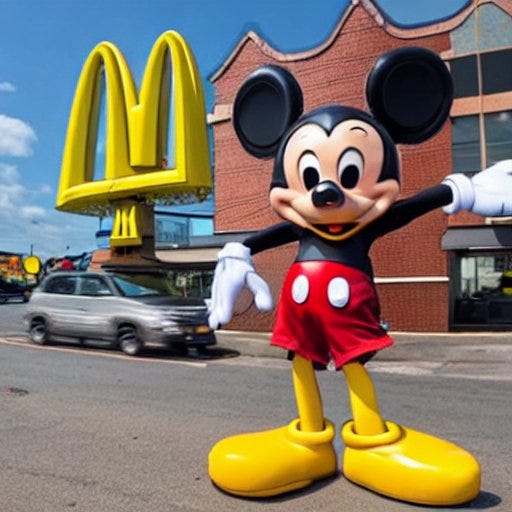
The AI software Stable Diffusion has a remarkable ability to turn text into images. When I asked the software to draw “Mickey Mouse in front of a McDonald's sign,” for example, it generated the picture you see above.
Stable Diffusion can do this because it was trained on hundreds of millions of example images harvested from across the web. Some of these images were in the public domain or had been published under permissive licenses such as Creative Commons. Many others were not—and the world’s artists and photographers aren’t happy about it.
In January, three visual artists filed a class-action copyright lawsuit against Stability AI, the startup that created Stable Diffusion. In February, the image-licensing giant Getty filed a lawsuit of its own.
“Stability AI has copied more than 12 million photographs from Getty Images’ collection, along with the associated captions and metadata, without permission from or compensation to Getty Images,” Getty wrote in its lawsuit.
Legal experts tell me that these are uncharted legal waters.
“I'm more unsettled than I've ever been about whether training is fair use in cases where AIs are producing outputs that could compete with the input they were trained on,” Cornell legal scholar James Grimmelmann told me.
Generative AI is such a new technology that the courts have never ruled on its copyright implications. There are some strong arguments that copyright’s fair use doctrine allows Stability AI to use the images. But there are also strong arguments on the other side. There’s a real possibility that the courts could decide that Stability AI violated copyright law on a massive scale.
That would be a legal earthquake for this still-nascent industry. Building cutting-edge generative AI would require getting licenses from thousands—perhaps even millions—of copyright holders. The process would likely be so slow and expensive that only a handful of large companies could afford to do it. Even then, the resulting models likely wouldn’t be as good. And smaller companies might be locked out of the industry altogether.
A “complex collage tool?”
The plaintiffs in the class-action lawsuit describe Stable Diffusion as a “complex collage tool” that contains “compressed copies” of its training images. If this were true, the case would be a slam dunk for the plaintiffs.
But experts say it’s not true. Erik Wallace, a computer scientist at the University of California, Berkeley, told me in a phone interview that the lawsuit had “technical inaccuracies” and was “stretching the truth a lot.” Wallace pointed out that Stable Diffusion is only a few gigabytes in size—far too small to contain compressed copies of all or even very many of its training images.
In reality, Stable Diffusion works by first converting a user’s prompt into a latent representation: a list of numbers summarizing the contents of the image. Just as you can identify a point on the Earth’s surface based on its latitude and longitude, Stable Diffusion characterizes images based on their “coordinates” in the “picture space.” It then converts this latent representation into an image.
Promoted Comments